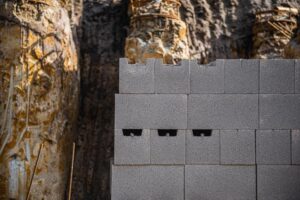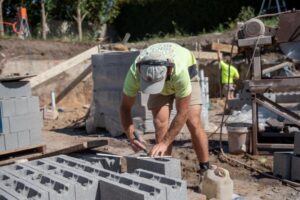The steps to residential blocklaying are preparing the site and laying foundation, laying the first course of blocks, ensuring level and plumb in block walls, and finishing up by pointing and acid washing. Following these steps is vital to ensure the proper installation of blocks in a project.
Working with an experienced blocklayer in Melbourne guarantees that the job will be completed the right way.
In this blog, we’ll talk more about the steps to residential blocklaying.
Steps to Residential Blocklaying
The following are the steps to residential blocklaying:
Prepare Site and Lay Footing
Start by clearing the site of any debris or overgrown vegetation to create a clean slate for your project. Use string lines and pegs to mark the layout.
Dig out the area for your footing, taking into account the type of soil and local building regulations. Pour your concrete footing accoding to engineering, making sure it’s level and wide enough to support your block wall, installing steel reinforcement bars as you go.
Give the foundation ample time to cure to prevent cracking later on. One of the key mistakes to avoid in blocklaying is rushing this stage.

Lay the First Course of Blocks
With your footing poured and cured, it’s time to lay the first course of blocks. Layout your profiles and stringlines for the first course, taking your time to ensure the layout is correct. Once your layout is complete, begin to lay the first course of blockwork starting at the corner.
Use a spirit level to check alignment – this first course is crucial, as it sets the stage for the rest of the wall. Keep your mortar joints consistent, around 10mm thick, for stability and a neat finish.
Make good use of your blocklaying tools, like trowels and blocksaws as required, to cut blocks as needed. Getting this first course right is key to a smooth build.
Ensure Level and Plumb Block Walls
Keeping your walls level and plumb is essential for a strong, straight structure. Regularly check your work with a spirit level and string line to ensure each block aligns perfectly both horizontally and vertically.
Apply mortar evenly ensuring your blockwork sits closely and consistently to your stringline. As you build, constantly inspect and adjust to maintain precision.
One of the biggest mistakes to avoid in blocklaying is neglecting these checks, which can lead to major structural problems down the line. Diligence here ensures your wall is both robust and visually appealing.
Finish Up By Pointing and Acid Washing
When your wall reaches its desired height, it’s time to add the finishing touches with pointing and acid washing as required. Pointing involves filling and smoothing the mortar joints to create a clean, weather-resistant finish.
Use a pointing tool to press mortar firmly into the joints and shape it neatly. Once the mortar has set, perform an acid wash to clean the blocks and remove any mortar smears if your final product will be facework. Mix the acid solution according to the instructions, scrub with a brush, then rinse thoroughly with water.




